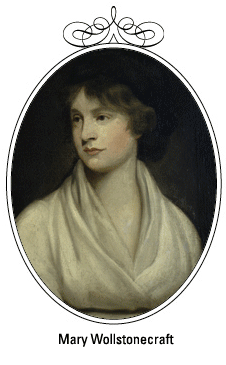Introduction
In the Britain of the 1780s, life was more rigidly stratified than it is
today: people generally knew where they belonged, and law and custom
kept them there. Women labored under special disabilities. Politically
disenfranchised, they also could not join the professions and were barred
from many jobs.
Married women had no rights to property or even to their own children.
Centuries
of common sense claimed that women were less than men in every way except
their ability to bear children. In the wake of the French Revolution,
however, political equality and something like a sexual revolution for
women seemed
possible, and thanks in part to Mary Wollstonecraft's
A Vindication
of the Rights of Woman (1792), the legal and social restrictions under
which women lived were briefly but hotly contested during the period we
now call
the Romantic era (1789–1837).
By the time Victoria inherited the throne in 1837, other, gentler changes
had come about. Genteel women no longer laughed at bawdy jokes or made
them as they had in the eighteenth century. Noblewomen no longer ruled
the fashionable
world by establishing private casinos, and their political campaigning
was largely confined to the drawing room. By 1800, many women had begun
to understand
motherhood as a sacred calling. This transformation in women's lives
also produced poetry, novels, plays, and paintings; new ways of understanding
feminine sexuality; and new feminine roles in British culture. Not least,
it produced—and was produced by—some fascinating women: wives,
mothers, and lovers, as well as actresses, botanists, poets, novelists,
travelers, sculptors, astronomers, courtesans, and utopians.
Many were helped by being born into wealthy families, or by having parents
who encouraged them to accomplishments beyond what was expected for girls.
A few gained autonomy by declining to marry. Almost all were born with talents,
energies, or temperaments that made them—loudly or quietly, gracefully
or awkwardly—fighters. Before Victoria: Extraordinary Women of
the British Romantic Era tells the stories of some of these women, putting them
in the context of their extraordinary revolutionary moment.
This website provides an overview of the exhibition Before Victoria, on
view at The New York Public Library from April 8–July 30, 2005.
Exhibition Curators:
Stephen Wagner, Curator, The Carl H. Pforzheimer Collection of Shelley
and His Circle, The New York Public Library
Elizabeth Campbell Denlinger, Research Associate, Shelley and his Circle
This exhibition was made possible in part by The Carl and Lily Pforzheimer
Foundation, Inc., and The New York Public Library’s Carl H. Pforzheimer
Collection of Shelley and His Circle.
Support for The New York Public Library’s Exhibitions Program
has been provided by Celeste Bartos, Mahnaz Ispahani and
Adam Bartos, Jonathan Altman, and Sue and Edgar Wachenheim III.

